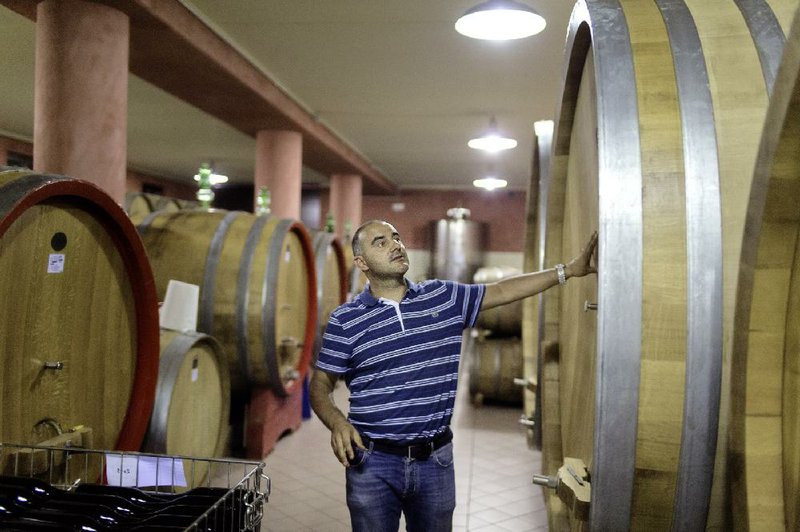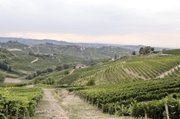LA MORRA, Italy -- On a road winding through the heart of Barolo country, Michele Reverdito pulled his car over and stepped onto a sloping and sickly vineyard.
"Look at the wilting leaves and how small and shriveled the grapes are," he said, holding a sad bunch of nebbiolo grapes in his hand on yet another hot August day.
The 48-year-old winemaker explained that unlike his own nearby vines, which were old, with deep roots, these vines were unable to tap the earth's underground reserves of water, leaving grapes vulnerable to this year's drought and brutal summer sun.
"Nebbiolo means the wine of the fog because you picked the grapes in November," he said. "Now we pick in September! The world is changing."
In vino veritas. The warming temperatures, shortening of the seasons and unseasonal storms brought on by global climate change are hastening the harvest of perhaps the most venerable crop of Western civilization.
Wine producers in this prized territory debate the effect on the end product, but there is a general acknowledgment that the heat and hail and the extreme weather in between present an annual challenge.
A 2016 study by NASA and Harvard of grape harvest dates going back to the 1600s found that climate change had pushed harvests dramatically forward in France and Switzerland in the second half of the 20th century.
Other studies have suggested that traditional wine-growing regions in Europe and around the world will become too hot for the berries traditionally linked to their earth and climate, or terroir, and will be forced to adopt varietals built for heat.
The vexing possibilities are worthy of contemplation over a fine wine: What is Bordeaux if it becomes inhospitable to cabernet franc or merlot? What is Burgundy without pinot noir? What if southern England supplants Champagne as a home to sparkling wine?
In Italy, a heat wave this year, given the name Lucifer, is blamed for an expedited picking and reduced yields of Franciacorta sparkling wine. Wine production overall is expected to drop up to 15 percent nationwide.
In Piedmont, where an ancient ocean enriched the land with minerals and the sun kissed the hills in just the right way, the Italian news media noted with shock the harvesting of grapes for white wine in July.
The local chapter of Coldiretti, the Italian agricultural lobby, noted that the harvest of grapes for Barolo, which often reached into November, now took place weeks earlier.
"People are picking grapes in their bathing suits and they used to be in gloves and overcoats!" local wine enthusiast Piero Comino, 63, said over a straw-colored glass of arneis in Neive.
On the hills under the Castello di Neive, six workers moved in pairs in mid-August, expertly cutting bunches of pinot nero grapes and dropping them in plastic red crates. A week earlier, they had already cleared an adjacent vineyard of the delicate grapes used to make their bubbly Spumante.
"It's twenty days earlier on average due to climate change," Ion Bruno, 50, a worker who has been picking the grapes for the past three decades, said as he clipped a stem.
Drought, more than heat, threatened the grapes, he said, adding that instead of steady rainfall, precipitation now came in downpours that ran off the hillsides and did little to slake the thirst of the vines.
"Decades ago there would be snow on the ground in November," said his partner Bruno Novelli, 58, as they moved to a new vine. "And now it doesn't snow anymore."
Those changes required careful management from winemakers, several of whom said that, if correctly harnessed, the heat could improve their product.
Claudio Roggero, who as enologist at the Castello di Neive, decides, among other things, when to pick the grapes, strolled with satisfaction through the corridors of vines, saying the grapes looked perfect.
"If I left these grapes another week they could have been like this," he said stopping in front of a rare sunburned bunch. "It's very dangerous."
In the middle of August, a barometer planted in one of their vineyards showed heat in excess of 104 degrees Fahrenheit. "It went off the charts," the wine estate's owner, Italo Stupino, 81, said as he looked over the hills.
Stupino also pointed at vineyards destroyed by a hailstorm in April, and yet he expressed doubt that global warming drove the change.
"I believe it up to a certain point," he said with a shrug. "The temperature goes up and down. We had hail in April and I remember some hot, hot Augusts as a boy."
That sentiment ran through the hills.
In Monforte d'Alba, just outside the town square, Giovanni Rocca stepped out onto his hills and happily chewed a grape he picked from his vineyard.
"The grapes are beautiful, the heat's good for them," he said, arguing that the vintage, which he said would probably come 10 or 15 days earlier than usual, was likely to yield a lower-quantity but higher-quality Barolo.
His son, Maurizio, 37, also spoke of the benefits of the sunshine. But he added that temperatures in excess of 100 degrees "are not good for the wine -- the berries become unbalanced and too fat, with too high an alcohol content."
He said they knew how to deal with anomalies, but if intense heat waves became permanent, "We'll have to plant bananas and pineapples."
SundayMonday Business on 08/27/2017

